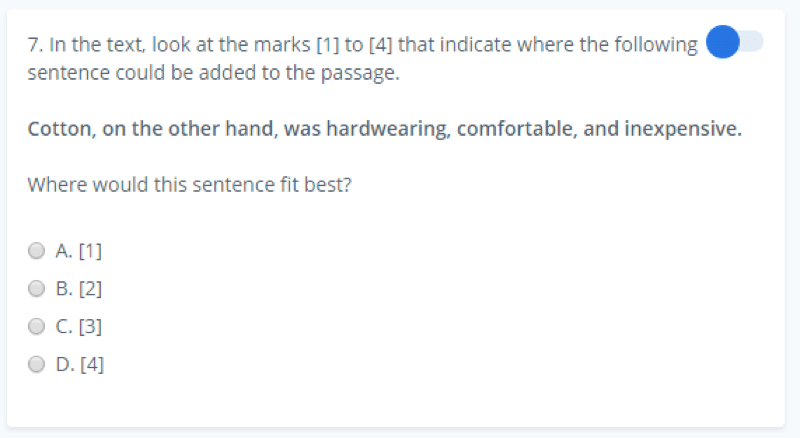On the TOEFL IBT exam, there will usually be one Insert a Sentence question per passage. However, it can be one of the more time-consuming questions, as you will need to try each and every answer choice to see which one makes the most sense. This type of question tests your ability to see the logical flow of a reading and the connections between sentences.
In this article you will learn how to insert a question per passage and enhance your English skills.
Explanation
This question type gives you a sentence and asks you where it would best fit in a paragraph from the passage. The best way to complete this question is to reread the respective paragraph four times, each time with the sentence inserted into a different corresponding spot.
Example
This type of question will look something like the example below.

As we see in the text, there are four marks that each correspond to an answer choice. We need to find out where is the best position for the sentence:
Cotton, on the other hand, was hardwearing, comfortable, and inexpensive.
The best way to do that is to reread the paragraph of text four times, each time inserting the sentence in a different position. If we start with [1], it would go something like this:
Wool production was difficult to mechanize because centuries-old laws protected traditional ways of making it. Cotton, on the other hand, was hardwearing, comfortable, and inexpensive. Conversely, by the 1740s silk was already being machine-made in factories in Derby and Macclesfield with equipment based on pirated Italian designs. But it was too delicate and expensive for mass consumption. [2]Unlike wool, the production of cotton was not controlled by ancient practices because it had only become widely available after the East India Company began exporting it from India in the late 17th century. [3]Inventors therefore bent their minds to create cotton-processing machines, and cotton spearheaded British industry into the factory system. [4]
For now, this does not seem to make much sense. We need to find the spot that makes the paragraph logically flow as a whole. In this particular sentence, the phrase “on the other hand” gives us a hint that there should be some kind of contrast in the previous sentence. We do not have this here. Let us try the next insertion point:
Wool production was difficult to mechanize because centuries-old laws protected traditional ways of making it. [1]Conversely, by the 1740s silk was already being machine-made in factories in Derby and Macclesfield with equipment based on pirated Italian designs. But it was too delicate and expensive for mass consumption. Cotton, on the other hand, was hardwearing, comfortable, and inexpensive. Unlike wool, the production of cotton was not controlled by ancient practices because it had only become widely available after the East India Company began exporting it from India in the late 17th century. [3]Inventors therefore bent their minds to create cotton-processing machines, and cotton spearheaded British industry into the factory system. [4]
This seems to make more sense. We would go on to do the same thing for spots [3] and [4], which do not seem to work. So we would go back and choose choice (B) as our correct answer. Insertion point [2] seemed to work the best because the previous few sentences are talking about wool, and the following few sentences are talking about cotton. This makes it a perfect transition point.
Tips
- Even if you come across a choice that makes sense right away, continue and insert the sentence in all four spots.
- Look right away for linking words in the sentence to be inserted. Our example had the phrase on the other hand as linking words.
Check here the other Tips and skills:

